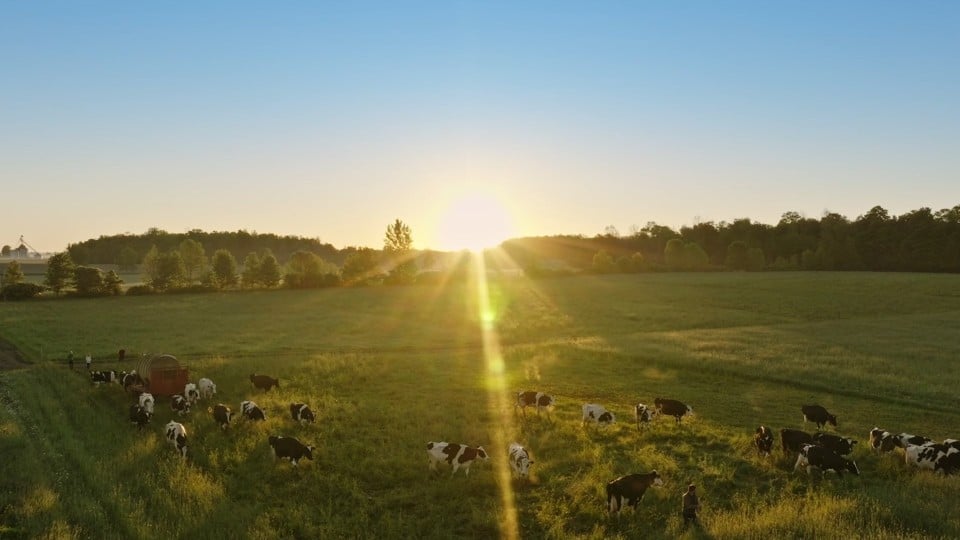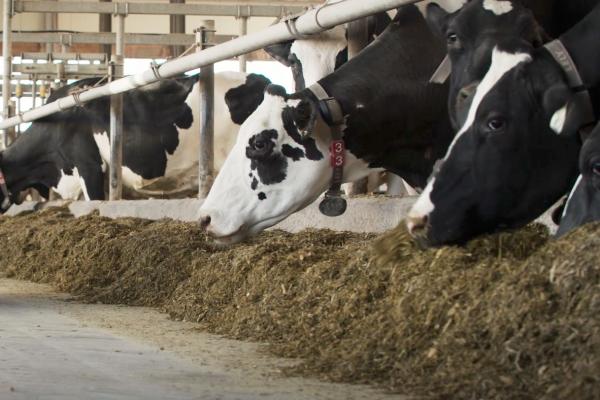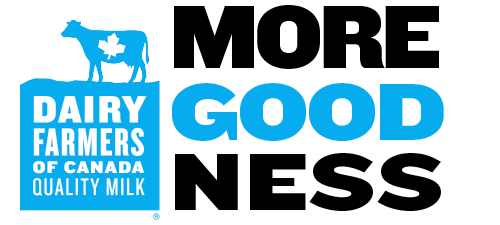57 Environmental Practices
Each Canadian dairy farmer follows proAction®, a mandatory national quality assurance program that establishes the framework for sustainable farming through 57 environmental practices.

proAction® is a national quality assurance program for the Canadian dairy sector. It's mandatory on all Canadian dairy farms, providing a framework for high standards of farming. Under proAction, farmers demonstrate excellence in six distinct areas: milk quality, food safety, animal care, livestock traceability, biosecurity, and environment.
Under proAction, dairy farmers advance the principle of continuous improvement, so consumers can be confident that the milk they enjoy was produced with the long-term health of our environment in mind.
List of 57 Environmental Practices
"One of the best ways to know how much fertilizer and manure to apply to get most benefit and least cost and reduce surpluses, is to sample the soil in each field randomly to about 30cm in early spring and send to a lab for analysis. Analysis will be for mineral nutrients needed for crop nutrient but also acidity and salinity depending on soil and locations. Over time, say 5 years, it would be good to assess soil carbon to ensure that the farm practices being used like tillage and erosion mitigation are helping to stabilize or improve the soil. Soil compaction should also be tested as compaction reduces yield and increases runoff."
- Shabtai Bittman, researcher at Agriculture and Agri-Food Canada, British Columbia
Soil Health
Reducing soil compaction
1. Controlled traffic patterns/traffic limited to specific areas
2. Avoid traffic in fields when conditions are unsuitable (e.g., very wet)
3. Limit the frequency of traffic
4. Equip machinery that enters fields with large-width tires, dual or triple wheels, or tracks
5. Ensure that tractor tires are inflated and that the tractor is ballasted (balanced)
6. Apply liquid manure with a dragline instead of with tankers
Reducing soil erosion
Read more about Protecting Soil
7. Minimum tillage is practiced consistently in all fields
8. Grassed waterways or permanent cover in areas prone to erosion
9. Shelterbelts or tree windbreaks around fields
10. Riparian zones or buffer strips to prevent soil loss to surface water
11. Landscape restoration is practiced to replace eroded soil with hilltops, where applicable
12. Cover crops are planted in shoulder seasons or inter-seeded in long-season row crops
13. Cross slope or contour cropping
14. Tile outlet protection (e.g. rock chutes)
15. Water and sediment control basins
Building soil carbon
Read more about Soil Carbon
16. A minimum of a 3-year crop rotation (including deep-rooted or long-term perennials at least 2 years in a row)
17. Rotational grazing
18. Spreading manure at a rate for crop requirements, preferentially to the application of synthetic nitrogen fertilizer
19. Intercropping
Areas of low productivity of salinity
20. Treat field areas of low productivity or salinity differently (e.g., keep them in perennials, salt-tolerant crops)
Greenhouse Gases
Assessing and reducing energy use
Read more about Energy Efficiency
21. Farm has undertaken an energy audit/assessment
22. Farm has installed energy efficient components:
- lighting
- ventilation
- milkhouse equipment (e.g. efficient vacuum pumps, plate coolers, water heaters)
other farm equipment (e.g. irrigation equipment)
23. Farm consistently uses reduced tillage practices
24. One or more pieces of farm machinery have been converted from diesel to electric or renewable natural gas motors
Reducing greenhouse gas emissions
25. The farm works with a ruminant nutritionist with the aim of:
- achieving low milk urea nitrogen (MUN)
- targeting reduced enteric emissions (through e.g. additives, fats in the ration, etc.)
- increasing feed efficiency
- improving animal health
26. The farm fully empties manure storage 2+ times per year
27. Manure management technology to reduce emissions is used (e.g. cover, composting with or without solid-liquid separation, biodigester)
28. The farm has invested in renewable energy and is in operation on the farm:
- biogas (e.g. biodigester)
- solar (e.g. solar panels)
- wind (e.g. wind turbines)
- other
29. The farm purchases renewable energy for use on the farm
30. Participated in a research project related to greenhouse gases
31. Used a recognized on-farm tool (i.e. Dairy Farms +, Holos, Cool Farm Tool) to estimate greenhouse gas emissions
"Dairy manure is an excellent source of all needed crop nutrients and even builds up soil carbon. New methods of using dairy manure improves its effectiveness for crops and minimizes potential impact on air, water, and climate.
Cover crops, intercrops and crop rotations increase biodiversity and sometimes also [the presence of] pollinators."
- Shabtai Bittman, researcher at Agriculture and Agri-Food Canada, British Columbia
Biodiversity
Wetlands and watercourses
Read more about our Partnership with Ducks Unlimited Canada
32. Restored or enhanced any wetlands in the past 10 years, including those constructed to filter manure or milking centre wastewater
33. Have not drained any wetlands in the past 10 years
34. Fenced or otherwise managed access to watercourses to limit livestock access
35. Fenced wetlands to exclude livestock
36. Left a vegetated area to buffer watercourses or wetlands
Protecting biodiversity
Read more about Biodiversity
37. Installed bat boxes, cavity nest boxes or bird boxes
38. Fenced-off or maintained natural areas for wildlife habitat
39. Maintain corridors between natural areas through active cropping or other agricultural areas, e.g., through fencerows, ditches, buffer strips, shelterbelts, flower strips, prairie strips, etc.
40. Hove not converted forest or native grassland into crop production in the past 10 years
41. Have not converted tame pasture land into crop production in the past 10 years*
42. Returned cropland to forest or to grassland in the past 10 years
43. Left piles of rocks undisturbed in uncropped areas, (e.g., shelterbelts or field edges (for reptile habitat))
44. If you cut firewood from your forest, leave standing dead trees (for woodpeckers and cavity-nesting birds)
45. In the past two years, altered actions on the farm due to the presence of a particular species (e.g., Practices delayed hay harvest until after July 15th or left area uncut after seeing bobolink, increased buffer around a wetland because of duck nesting, etc.)
46. Practice rotational grazing
47. Developed a biodiversity plan for your farm in partnership with a conservation organization
48. Signed a conservation/stewardship agreement or Conservation Easement with a conservation organization to set aside parts of your farm for wildlife habitat
- Examples of conservation organizations include: Ducks Unlimited Canada (DUC), Nature Conservancy of Canada (NCC), Manitoba Habitat Heritage Corporation (MHHC), Fondation de la faune (fauna foundation), or other agro stewardship groups, watershed or conservation authority
Managing pollinator habitats and health
49. Installed, or have allowed others to install, beehives on the farm
50. Take steps to minimize the use of agrochemicals, especially pesticides, through actions such as prairie strips, intercropping, and the maintenance of diverse habitats around fields, etc.
51. Practice integrated pest management (IPM) or are certified organic in their crop production (IPM is based on principles of prevention, observation, monitoring, and appropriate intervention)
52. Monitor and identify pests before applying pesticides at a predetermined threshold; blanket applications of pesticides are avoided
53. Pesticide application records are maintained (e.g., pesticide vendor, reason for spraying, trigger for spraying (i.e. threshold), product name, rate applied, area sprayed, date, time of day, weather conditions (wind speed, temperature, cloud cover, relative humidity), soil moisture, growth stage of crop and growth stage of weeds/insects/disease)
"Diverse crops are helpful especially on a landscape level. It is best when there are diverse farms and when crops and field edges are managed to promote trees and woody vegetation. This approach will provide diverse wildlife refuge and across the landscape with diverse crops and organic amendments like manure will improve soil health and biological diversity of microbes to invertebrates to small vertebrates."
- Shabtai Bittman, researcher at Agriculture and Agri-Food Canada, British Columbia
Other
Limiting the production and runoff of silage seepage from the farm’s silage storage
54. A silage seepage collection system is installed and maintained on the farm
55. Silage storage is located away from AND downslope from surface water or directed away from wells and watercourses
56. Horizontal silos have a roof or covering and sit on a concrete pad instead of directly on the soil
Managing plastic farm waste
Read more about Reducing and Recycling Plastics
57. Chemical containers and other plastic waste (e.g. twine, bale wrap, silage covers, feed bags, etc.):
- recycled
- returned using a take-back program
- reused or repurposed
- the farm reduces plastic waste by using fewer plastics or selecting products/product packaging with a lower environmental impact (e.g., reusable, biodegradable, or less plastic)
- disposed of at a landfill








